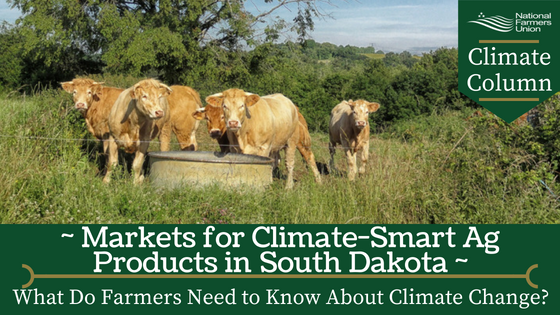 By Kiana Brockel, NFU Intern
By Kiana Brockel, NFU Intern
Climate Column readers know there are many things farmers can do to mitigate the negative impacts of climate change. The Natural Resources Conservation Service (NRCS) within the U.S. Department of Agriculture (USDA) offers farmers technical and financial support to help interested farmers mitigate climate change and become more climate resilient. In every state throughout the U.S., the State Conservationist considers the advice of bodies like the State Technical Committee to identify key conservation priorities. NRCS in that state focuses resources and programs like the Grasslands Reserve Program (GRP) or the Environmental Quality Incentives Program (EQIP) on these priorities. Farmers can secure more support for practices and management decisions that work toward the state priorities.
Excluding Alaska, no area in the U.S. has seen average annual temperature warm more quickly over the past century than the Northern Plains. Warmer temperatures in South Dakota will lengthen growing seasons, creating the potential to cultivate corn and soybeans in areas that were previously unsuitable. However, dramatic changes to the ecology of the state will come at a cost to farmers.
As the state gets warmer, the potential for heavy storms and flooding increases. If more grassland is converted to cropland for corn and soybean production, the more vulnerable the area is to flooding and soil erosion, which could potentially cause dust storms reminiscent of those during the 1930s. The combination of heavier storms, increased flooding, and land use change could cause water pollution to spike.
In a state like South Dakota, where agriculture adds $25.6 billion to the state economy, finding ways to promote agricultural production while also mitigating the effects of climate change is vital. The State Conservationist has identified grasslands conservation, including grasslands for grazing livestock, and improving water quality as statewide priorities. Some strategies for achieving these goals include planting grasses on marginal croplands, planting trees for wildlife and livestock protection, developing drought plans proactively, and restoring native plants and animal communities. Resilient grasslands for grazing will help producers reduce feed costs and may also assist interested farmers to earn a premium for grass-finished product.
Well-managed grazing lands are beneficial not just to farmers utilizing them; they also provide valuable ecosystem services. One example of this is the filtering properties grazing lands can provide to maintain and restore water quality. Healthy vegetation traps sediments before they reach waterways, cleansing the runoff and minimizing surface water pollutants. Healthy grasslands also enhance groundwater recharge by slowing runoff, allowing more water to be absorbed into the soil.
The Kopriva Ranch near Raymond, South Dakota, is showcased by the NRCS for their outstanding grazing management. On their ranch, the Kopriva’s focus on grazing longer and being less dependent on harvested or purchased grain. They have implemented cover crops and crop residue stubble to extend grazing seasons. They also practice rotational grazing to prevent overgrazing and maximize forage growth. NRCS Resource Conservationist John Lentz suggests that ranchers maintain half the weight of the plant. Grassland plants need a certain amount of leaf material to recycle sunshine into energy to be stored in the roots. To ensure a plant can regenerate the following spring, grazing management is needed so a plant can obtain enough energy.
GRP could be a useful tool for farmers looking for ways to implement more climate conscious practices. Participants voluntarily limit future development and cropping uses of the land, but retain the right to conduct common grazing practices. The land can continue to be used for hay production. Livestock producers could benefit greatly, particularly those considering transition to grass-fed production.
EQIP may also be useful for those farmers who would not benefit from limited crop production. Farmers can receive financial and technical assistance to implement structural and management conservation practices that optimize environmental benefits on working agricultural land. In South Dakota, these priority resource concerns include soil, water, wildlife, air quality, and related natural resource concerns. Making improvements in any of these priority areas could be assisted by an EQIP contract.
Yet despite NRCS’s support for grasslands management, producers interested in marketing grass-finished meat often experience challenges getting their product to consumers. In January 2016, there were only six federally inspected livestock slaughter plants in South Dakota. Nationwide, there are approximately 800, down from over 1,000 in 1992. As the number of slaughterhouses fall, meat production increases, indicating consolidation. That consolidation makes it harder for producers to get smaller or niche orders to consumers. State inspection is an option, but it limits marketing options.
Could new, federally inspected livestock slaughter infrastructure at a scale appropriate to grass finished production be built in South Dakota? The Local Food Promotion Program, run by USDA’s Agricultural Marketing Service (AMS), is a competitive grant program that makes funds available for feasibility studies to answer questions like this. Producers interested in marketing grass finished product could work together with Farmers Union to win grant money in order to determine whether there’s adequate demand in their area for scale-appropriate inspected processing for their animals. The same program can also fund the actual buildout of such capacity; in 2017, Hoku Nui Maui, LLC won $463,710 to purchase and manage a Mobile Slaughter Unit (MSU) and Mobile Cut and Wrap Unit in Hawaii.
Farmers can come together with farm organizations to see the process of climate-smart agriculture from implementation of beneficial practices all the way through marketing the resulting products. Stay tuned in future week as we discuss state-by-state conservation goals and opportunities.
Like what you’ve read? Check out our Climate Leaders home page, join the conversation in the NFU Climate Leaders Facebook Group, and keep up-to-date with NFU climate action by signing up for the mailing list.

